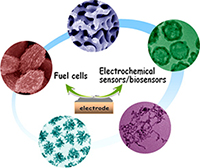The Noble Architecture of New Materials
Invited review shows progress in building ordered or chaotic structures for fuel cells
(October 2015)

The researchers discuss the state-of-design-science for porous materials that could serve as catalysts in fuell cells and in certain types of sensors. Copyright 2015: American Chemical Society
Power without pollution. That's the dream. Fuel cells could help make that dream a reality, but the cells suffer because of the carbon-based materials that support the platinum. The platinum catalyzes the quick, clean conversion of a fuel into electricity. The support often lets the platinum dissolve, form into clumps, or escape. The result is that the fuel cell fails. But new material architectures keep the platinum in place. Dr. Yuehe Lin at Pacific Northwest National Laboratory and his colleagues described the state of the science in building such materials in an invited article in Chemical Reviews. They examined highly ordered materials with nanometer-sized pores along with nanofoams and other less structured materials. The new materials contain an interconnected network of pores that both protect the platinum and allow it to work.
Why It Matters: For fuel cells to play a larger role in the energy landscape, they must be mass produced cost effectively, and that means creating low-cost, highly active, stable materials to catalyze the reaction. Porous nanosized structures that can hold platinum and other noble metals can be directly used in such a way as to circumvent the problems of today's carbon-supported catalysts.
What's Next? In spite of the progress described in this invited review, there are still many challenges ahead. Precise control is needed of the size, shape, composition, and structure of the materials' building blocks, which determine the structure and function. Also, a better understanding of how the materials grow, or don't, is needed. And it all requires advances in experimental and theoretical techniques.
Acknowledgments
Sponsors: This work was supported by a start-up grant from Washington State University and a Laboratory Directed Research and Development program at Pacific Northwest National Laboratory. Chengzhou Zhu and Alexander Eychmüller also acknowledge the Alexander von Humboldt Foundation. Dan Du acknowledges the financial support of the National Natural Science Foundation of China and the Program for New Century Excellent Talents in University.
Research Area: Chemical Sciences
Research Team: Chengzhou Zhu, Washington State University; Dan Du, Washington State University and Central China Normal University; Alexander Eychmüller, TU Dresden; and Yuehe Lin, has a joint appointment with Pacific Northwest National Laboratory and Washington State University.
Reference: Zhu C, D Du, A Eychmüller, and Y Lin. 2015. "Engineering Ordered and Nonordered Porous Noble Metal Nanostructures: Synthesis, Assembly, and Their Applications in Electrochemistry." Chemical Reviews 115(16):8896-8943. DOI: 10.1021/acs.chemrev.5b00255
Related recent papers:
Fu S, C Zhu, H Li, D Du, and Y Lin. 2015. "One-Step Synthesis of Cobalt And Nitrogen Co-Doped Carbon Nanotubes and Their Catalytic Activity for Oxygen Reduction Reaction." Journal of Materials Chemistry A 3:12718-12722.
Fu S, C Zhu, Y Zhou, G Yang, J Jeon, J Lemmon, D Du, SK Nune, and Y Lin. 2015. "Metal-Organic Framework Derived Hierarchically Porous Nitrogen-Doped Carbon Nanostructures as Novel Electrocatalyst for Oxygen Reduction Reaction." Electrochimica Acta 178:287-293.
